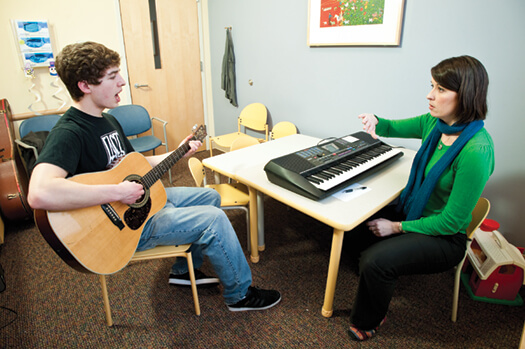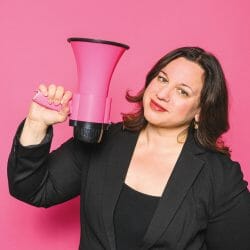Voices of Experience

Wilder Deitz (left) and Sarah Blakeslee (right) practice techniques for avoiding voice fatigue and a sore throat, including “safe screaming.” Photo: Bryce Richter.
These UW specialists tune up the human instrument.
Wilder Deitz is learning how to scream by doing jumping jacks.
The sixteen-year-old, who plays bass and guitar and sings vocals in a heavy metal/grunge band — The Pretty Victims — was suffering from voice fatigue and a chronic sore throat that were getting in the way of his musical ambitions. So how can jumping up and down improve his singing technique?
As strange as it sounds, Deitz’s regimen is not unusual at UW-Madison’s Voice and Swallow Clinic, which devotes some of its practice to helping professional and amateur singers, as well as others who rely on their voices to do their jobs, including teachers, attorneys, clergy, and actors. Performers passing through Madison on tour enlist the clinic’s help if their voices start to fail, and its strong reputation draws other patients from around the world.
Singers aren’t the only ones who struggle with their voices. About 28 million workers in the United States experience voice problems daily, causing them to miss work, receive disability assistance, or even change occupations, says Susan Thibeault PhD’01, director of the UW clinic, which, due to the strength of its research and clinicians, received the first and only voice training grant from the National Institutes of Health.
“People take their voices for granted,” Thibeault says.
And when things go wrong, drinking tea with honey and lemon isn’t a real solution. Fixing a voice problem relies on a patient’s commitment to make changes as much as the skill of doctors and voice specialists.
“We sometimes talk about vocal bank accounts. You can only take so much out, so you can only use your voice so much,” says Maia Braden ’00, MS’06, pediatric voice manager and one of two singing-voice specialists who focuses on working with children. Braden — a former opera singer — combines some of the vocal techniques she learned as a singer with her knowledge of the vocal mechanism, anatomy, physiology, and healthy voice production.
“It really becomes this hybrid of vocal techniques from singing-voice lessons and vocal techniques from voice therapy,” Braden says.
The adult clinic is equipped with a grand piano to work with patients who are singers, while the pediatric voice clinic at American Family Children’s Hospital is outfitted with electronic keyboards.
At the start of Deitz’s therapy session, the last in a series of six visits, voice specialist Sarah Blakeslee asks him what he has done to help his sore throat.
“Warm-ups before singing and bellowing,” he says. “That really helps.”
“You finally believe me,” Blakeslee says with a smile.
After she works Dietz through some scales, accompanying him on the keyboard, she asks him to play his guitar and sing a portion of a song where he pushes the limits of his voice. Despite the staid confines of the clinic room, she wants him to let loose and perform, demonstrating what he would do in front of an audience.
“Do exactly what you’re doing, but use twice as much air,” she says, consistently urging him to focus on expanding his rib cage.
Blakeslee then has Deitz scream as he counts from one to ten — while doing jumping jacks — and then as he bounces up and down. “There are safer ways to scream,” she says. “Engage the whole body so this,” she says, holding her hands at her throat, “doesn’t have to do all the work.”
Vocal coaching for performers who want to be better singers differs from treatment for those who have vocal trouble for medical reasons. “Let’s say someone comes in and they just [say] ‘Hi, I want to sound like Mariah Carey.’ We can give them therapy like a singing coach, but we can’t charge that [to insurance],” Thibeault says.
While surgery is sometimes required to correct vocal problems, therapy is the best course of action for most common issues, including nodules on the vocal folds. Professional voice users, such as singers, come into these sessions with a deeper awareness of what they are doing when they speak and sing, Thibeault says.
If a voice specialist asks average patients to give their voices some resonance, “They have no idea what you are talking about,” Thibeault says, while singers know their range and how to work with their voices.
“[Singers] are fully aware of what they’re doing and how to try and change that,” she says. “It’s more specialized, so it’s fun.”
The clinic also offers “voice boot camp,” allowing patients who travel to Madison from longer distances to be fully evaluated by clinic doctors and engage in up to a week of intensive therapy with specialists. Thibeault says the option has proven effective for people with problems that haven’t responded to other treatment.
Voice disorders can be difficult to pinpoint since they can be caused by a combination of medical problems and behavior. Why are opera singers able to sustain three hours of on-and-off forceful singing without injuries? And why do rock singers who definitely use their voices in less-than-healthy ways do just fine?
To find answers, the clinic takes a team approach to care, starting with a complete evaluation that looks at the patient’s behavior, including diet and other habits, and his or her vocal folds (also known as vocal cords). A scope with a halogen light is inserted through the nose or the back of the mouth to look at the structure of the vocal cords, and a strobe light is used to observe their function and vibration, which averages about 220 times a second for an adult female. The clinic also calls upon high-speed imaging to observe individual vibrations, using a camera that shoots between two thousand and seven thousand frames per second.
For clinic patients, acoustic and aerodynamic equipment measures variations in pitch and loudness, airflow through the vocal folds, and how much someone is pushing to sing. These tools are used post-therapy to measure improvement.
Still, Braden says, “The clinician’s ear is a very big tool.”
Jenny Price ’96, senior writer for On Wisconsin, wishes there were voice therapy techniques available to land her a guest-starring role on Glee.
Published in the Fall 2010 issue



Comments
Marie Von Behren August 28, 2010
Hey, Sarah and company,
Great work you are doing! All of us teaching voice have to trouble shoot at some point. I have gotten professors speaking in their lectures again, I’m glad to say. Thanks for the article!
Helen Rottier September 10, 2010
Sarah,
You probably don’t remember me, but I was in “Joseph” with you at St. Bernard’s.
Great work!
-Helen
Carol O. September 15, 2010
I have been diagnosed as having a cyst on one of my vocal cords. Do these always need to be surgically removed or is there another way to make it go away? Do these sometimes end up being cancerous? I am not a smoker and only have an occaional drink.
Thank you.
New Glarus Choir Student September 30, 2010
I go to the UW Madison home page to look at their application, and the first thing I see is Sarah, who just talked to my school’s choir about vocal health today. Funny Coincidence.
Bruce H. November 1, 2010
A couple of months ago I heard a segment on NPR about a doctor at the Cleveland Clinic who cured a woman who had completely lost her ability to speak above a whisper by massaging her throat and vocal cords for about 10 minutes. Are you familiar with that therapy and does anyone here do it? I was wondering whether singers who have certain difficulties, say with a tight throat or high notes, might benefit from that type of massage?